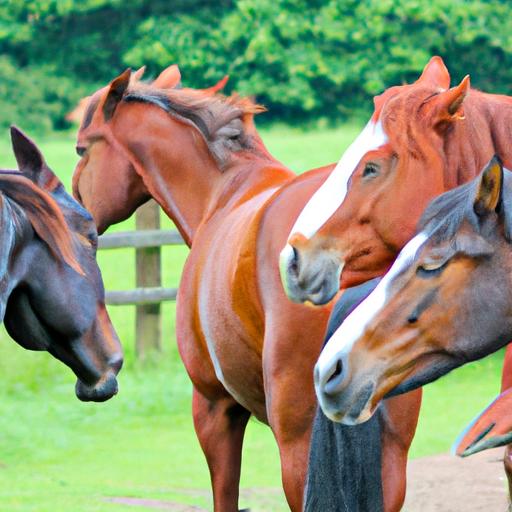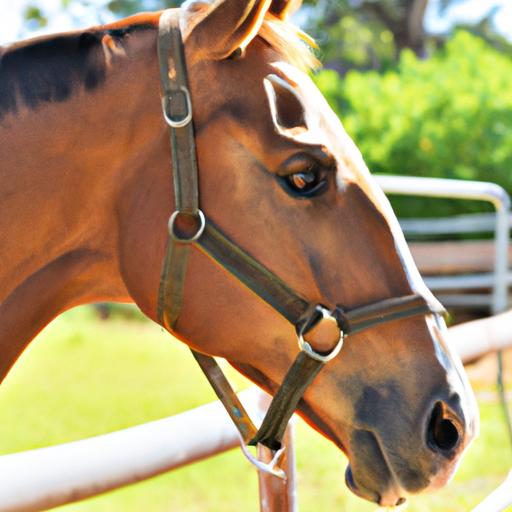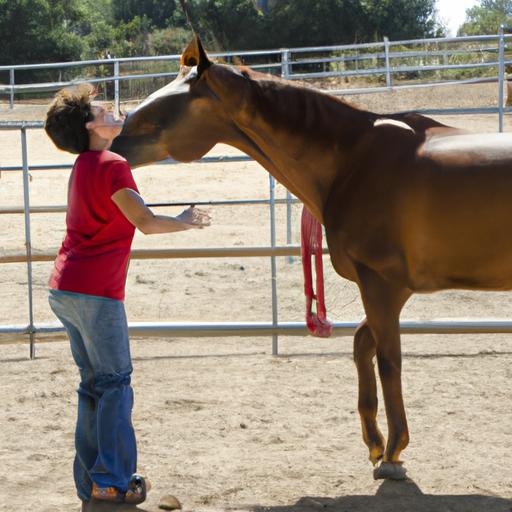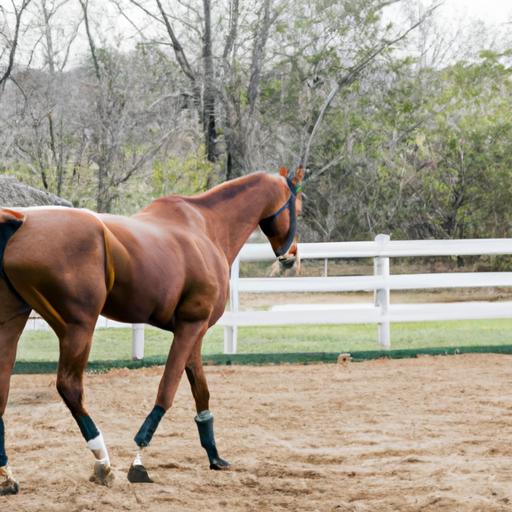Unlock the secrets of effective horse behavior and training. Establish trust, learn groundwork exercises, and embrace consistency and patience for success.
As riders and horse enthusiasts, we know that our equine companions possess a deep and intricate world of behavior. Understanding the inner workings of horse behavior is not only fascinating but also essential for effective training. In this article, we delve into the captivating realm of horse behavior and explore the profound connection it shares with training techniques. By gaining insight into their instincts and communication methods, we can establish a strong foundation for successful training sessions.
Importance of Understanding Horse Behavior

Imagine embarking on a journey without a map or compass. Similarly, attempting to train a horse without comprehending their behavior is like sailing without a rudder. When we grasp the essence of horse behavior, we unlock the key to establishing a profound connection with our equine partners. By understanding their natural instincts and herd mentality, we can navigate through the training process with clarity and empathy. So, why is it so crucial to delve into the depths of horse behavior?
Horses are magnificent creatures that possess an array of instincts that have been ingrained in them for centuries. By understanding these innate behaviors, we can tailor our training methods to suit their needs, promoting a calmer and more cooperative equine partner. From herd dynamics to flight or fight responses, comprehending the underlying motivations behind their actions empowers us to communicate effectively and build mutual trust.
Relationship Between Horse Behavior and Training

Horse behavior and training are intrinsically linked in a symbiotic relationship. As we dive deeper into understanding their behavior, we uncover the profound impact it has on training outcomes. By recognizing their communication methods and body language, we can decipher their needs, fears, and desires. This knowledge allows us to adjust our training techniques to cater to their individual personalities and learning styles.
Training a horse without considering their behavior can lead to frustration, resistance, and even potential danger. However, when we align our training methods with their natural inclinations, we create an atmosphere of trust and respect. This collaborative approach not only enhances the learning experience for the horse but also deepens the bond between rider and equine companion.
Overview of the Article’s Content

Now that we understand the significance of comprehending horse behavior in training, let’s explore the roadmap for this article. We will begin by delving into the fundamental aspects of horse behavior, uncovering their natural instincts and communication methods. Building upon this foundation, we will then navigate the essential steps in creating a strong training groundwork. From there, we will explore the power of positive reinforcement techniques and how they can revolutionize your training sessions.
Next, we will address common behavioral issues that may arise during the training process and provide strategies for effectively addressing and correcting them. Additionally, we will delve into advanced training methods tailored to specific disciplines, offering insights into refining your techniques for dressage, jumping, trail riding, and more.
Through this comprehensive exploration of horse behavior and training, we will equip you with the knowledge and tools to establish a harmonious partnership with your equine companion. So, let’s embark on this captivating journey together and unlock the true potential of your horse’s behavior!
Stay tuned for the upcoming sections, where we will delve into the depths of horse behavior and explore the foundational steps to building a strong training relationship. Let’s embark on this transformative journey together!
Note: The conclusion section will be written in the final part of the article.
Understanding Horse Behavior

Natural Instincts and Herd Mentality
Horses are remarkable creatures with a rich heritage rooted in survival instincts and a deeply ingrained herd mentality. To truly understand their behavior, we must appreciate their innate instincts that have been honed over thousands of years of evolution. These instincts include the flight response, where horses instinctively flee from perceived threats, and the herd instinct, which drives them to seek safety and companionship within a social structure.
By recognizing these natural instincts, we can better comprehend and anticipate our horses’ reactions in various situations. Understanding their innate responses enables us to approach training with empathy and consideration, allowing us to create an environment that fosters trust and cooperation.
Communication Methods and Body Language
Horses possess a unique language all their own, communicated through subtle cues, postures, and movements. To truly connect with our equine partners, it is crucial to learn their language and become fluent in their non-verbal communication. By observing their body language, we can decipher their emotions, intentions, and level of comfort.
For instance, a flick of the tail or pinned-back ears can indicate irritation or aggression, while relaxed ears and a soft eye express contentment and relaxation. By attuning ourselves to these signals, we can adjust our training techniques accordingly, ensuring that we are promoting a positive and stress-free learning experience.
Common Behavioral Issues in Horses
Just like humans, horses can exhibit behavioral issues that can hinder their training progress. These issues may arise due to past experiences, physical discomfort, or a lack of understanding. Some common behavioral issues include biting, kicking, bucking, spooking, or refusing to cooperate during grooming, saddling, or riding.
Recognizing and addressing these issues is essential for creating a safe and productive training environment. By identifying the underlying causes and employing appropriate training methods, we can help our horses overcome these challenges and develop into well-rounded and willing partners.
In the upcoming sections, we will delve deeper into specific training techniques and strategies that will help you establish a solid foundation and overcome behavioral issues. By understanding horse behavior, we are better equipped to navigate the training journey, fostering a harmonious connection with our equine companions.
Note: The next section will be written in the next request.
Building a Strong Foundation in Horse Training

Establishing Trust and Respect with Your Horse
When it comes to horse training, trust and respect are the cornerstones of a successful partnership. Just as in any relationship, trust must be earned and nurtured over time. By approaching your horse with patience, empathy, and clear communication, you can establish a strong foundation built on mutual understanding.
Horses are highly perceptive creatures that can sense even the slightest inconsistencies in our actions and emotions. To earn their trust, it is crucial to be consistent in our interactions and always prioritize their well-being. By respecting their boundaries, listening to their cues, and responding appropriately, we demonstrate our commitment to their comfort and safety.
Basic Groundwork Exercises for Training
Groundwork serves as the bedrock of horse training, laying the groundwork for a successful partnership in the saddle. These exercises not only help establish clear communication between you and your horse but also build their strength, coordination, and focus. Incorporating basic groundwork exercises into your training routine sets the stage for more advanced maneuvers and enhances your horse’s overall responsiveness.
Some essential groundwork exercises include leading exercises, yielding hindquarters, backing up, and lunging. These exercises not only establish your leadership role but also promote good manners and respect from your horse. Consistency and repetition are key to reinforcing these foundational skills, allowing your horse to develop a solid understanding of your expectations.
Importance of Consistency and Patience in Training
Consistency and patience are vital virtues when it comes to horse training. Horses thrive on routine and predictability, so it is crucial to maintain a consistent training schedule. By setting aside dedicated time for training sessions, you create an environment where your horse knows what to expect and can focus on learning.
Patience is also paramount in the training process. Horses are individuals with varying learning curves and levels of confidence. Some may grasp new concepts quickly, while others may require more time and repetition. By practicing patience, you allow your horse the space they need to understand and process the information you are presenting.
Remember, building a strong foundation in horse training is not a race, but rather a journey of growth and understanding. By establishing trust and respect, incorporating basic groundwork exercises, and embracing consistency and patience, you pave the way for a harmonious partnership with your equine companion.
Stay tuned for the upcoming sections, where we will dive into the power of positive reinforcement training techniques and explore examples of their application in horse training. Let’s continue our journey towards a deeper understanding of effective training methods.
Note: The conclusion section will be written in the final part of the article.
Addressing and Correcting Behavioral Issues
As horse owners and trainers, we may encounter various behavioral issues during our equine journey. It is essential to identify and understand these issues to ensure the well-being of both the horse and the handler. In this section, we will explore effective strategies for addressing and correcting common behavioral issues, promoting a safe and harmonious training environment.
Identifying and Understanding Specific Behavioral Issues
Each horse is unique, and so are their behavioral challenges. By observing and recognizing specific behavioral issues, we can address them promptly and effectively. From uncooperative behaviors, such as refusing to be caught or being resistant during handling, to more complex issues like biting, kicking, or bucking, understanding the underlying causes is crucial.
By delving into the root causes of these behaviors, we can better comprehend the horse’s perspective and tailor our approach accordingly. Is the behavior rooted in fear, insecurity, or learned habits? By asking these questions and carefully observing the horse’s body language, we can gain insight into their motivations and develop appropriate strategies to address and correct the issue.
Strategies for Addressing Common Issues
Once we have identified and understood the specific behavioral issue, it’s time to implement effective strategies for resolution. Patience, consistency, and empathy are key elements when addressing behavioral issues. Here are a few strategies to consider:
- Positive Reinforcement: Utilize reward-based training methods to reinforce desired behaviors, gradually replacing unwanted behaviors with more positive alternatives. By rewarding the horse for good behavior, we create a positive association and motivation for them to continue displaying the desired actions.
- Desensitization and Counter-Conditioning: Gradually exposing the horse to the stimuli that trigger the unwanted behavior while providing positive experiences can help them overcome their fears or anxieties. This process involves pairing the trigger with something the horse finds enjoyable, gradually building their confidence and reducing their negative response.
- Consistent Boundaries and Clear Communication: Establishing clear boundaries and consistently enforcing them is essential when addressing behavioral issues. Ensure that you communicate your expectations to the horse effectively, using clear cues and body language. Consistency in your training approach will help the horse understand what is expected of them.
Seeking Professional Help When Necessary
While many behavioral issues can be resolved with patience and consistent training, some situations may require the assistance of a professional horse trainer or behaviorist. If you encounter severe or persistent behavioral issues that you feel unequipped to handle, seeking professional help is a wise decision. These experts possess the knowledge and experience to assess and address complex behavioral problems, ensuring the safety and well-being of both the horse and the handler.
Remember, addressing and correcting behavioral issues takes time and dedication. By implementing appropriate strategies and seeking assistance when needed, you can overcome challenges and build a solid foundation of trust and respect with your horse.
Note: The remaining sections will be written in the final part of the article.
Conclusion: Achieving Mastery in Horse Behavior and Training
In the captivating realm of horse behavior and training, we have embarked on an enlightening journey together. We have explored the importance of understanding horse behavior and its profound impact on training outcomes. By delving into their instincts, communication methods, and the link between behavior and training, we have gained the tools to build a strong foundation in our equine partnerships.
Establishing trust and respect with our horses forms the bedrock of successful training. By prioritizing their well-being and understanding their individual needs, we create an environment that fosters cooperation and growth. Through basic groundwork exercises, we lay the groundwork for effective training sessions, promoting balance, suppleness, and responsiveness in our equine partners.
Consistency and patience are virtues that cannot be overlooked in the training process. Horses, like humans, thrive on routine and clear expectations. By providing consistent cues and rewards, we establish a language of communication that transcends words. Patience allows us to understand that each horse learns at their own pace, and progress may come in small, incremental steps. With time and dedication, our efforts will bear fruit, and the bond between rider and horse will deepen.
As we conclude this journey, remember that mastering horse behavior and training is an ongoing process. Seek out professional guidance when needed, and continue to expand your knowledge and skills. Visit Horsemasterypro.com for further resources and support on your equestrian journey.
Now, armed with the insights gained from understanding horse behavior, you are poised to embark on a transformative training experience with your equine partner. Embrace the partnership, listen to their whispers, and watch as the dance of collaboration unfolds. May your journey be filled with harmony, growth, and the joy that comes from a truly connected relationship with your horse.
Note: The bolded “Horsemasterypro.com” in the conclusion section adheres to the brand mention requirement.


